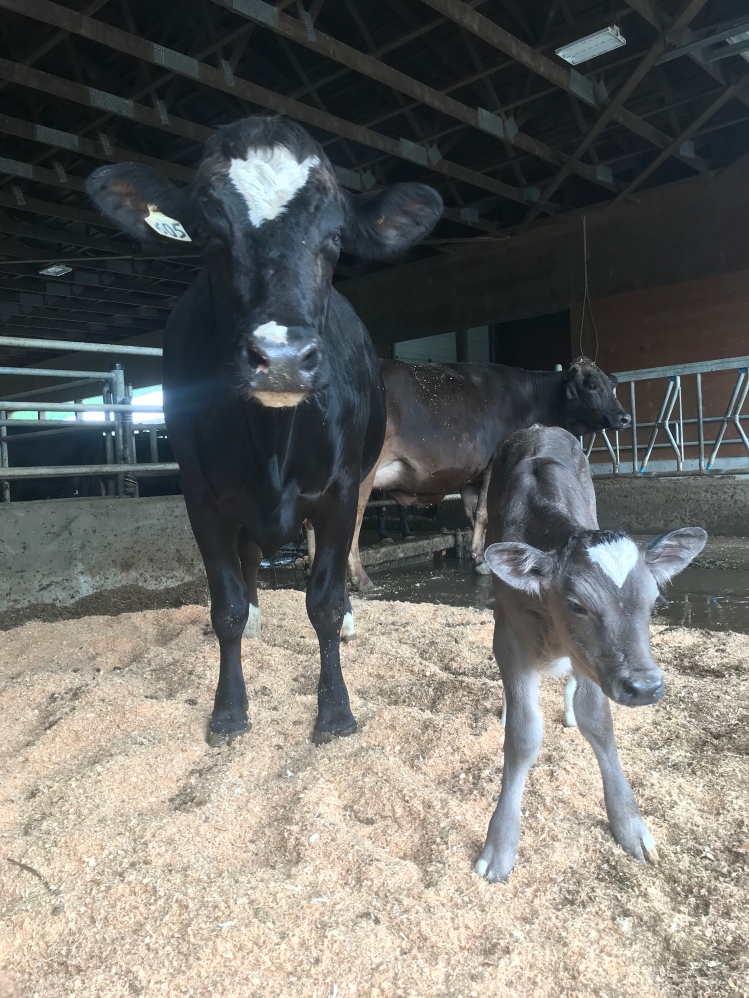Tuesday, May 21:
Mama Annie had her new calf – a heifer! 😍 – sometime over night between Sunday and Monday. When we came to the barn Monday morning, the calf was standing, all fluffy and dry after being thoroughly licked clean by her mama. However, it did not appear that she had nursed; her tummy was flat and she was bawling periodically. We milked Annie in the parlour, then bottle fed her colostrum to her very hungry calf. The two have been together since then and we have not yet observed the calf to be nursing, so like always, we feed her her mama’s milk with a bottle. We will move her to the calf nursery later today – about 36 hours after birth.
This is Annie’s second calf. As you can see in the video, Annie is not afraid of her farmer. Her calf, curious and precocious, runs up to the camera, perhaps thinking it is feeding time again. Annie watches, but she’s not nervous or overly protective. She knows from experience that her farmers will care for her and her calf with compassion, affection, and respect. When the time comes to move her calf to our comfortable calf nursery, we will do so calmly and gently. If Annie’s behaviour thus far is any indication – she’s been more interested in munching on feed at the feed bunk than in her calf – it will be the typical relaxed and stress free event it always is.
Wednesday, May 22:
Separating cows and calves is an emotionally loaded subject. Why? Because the reasons for and realities of the practice are not widely understood.
Too often, we attach our own emotions to animals, and while of course it is obvious that cows experience pain, fear, joy, and other emotions, they do not have exactly the same needs and preferences that humans do.
They don’t crave stimulating conversation, “Netflix and chill”, quality time with their spouse, a bed with blankets and sheets, nor many other human desires.
Coming from a non-dairy background myself, I at first was taken aback at the practise of separating cows and calves within a day or two after birth. Growing up, our beef cows spent several months with their calves until weaning time, and weaning was no fun: bawling calves & cows meant little sleep for the first few nights. However, once I saw for myself how neither the dairy cows nor their calves were unduly disturbed by the separation, my feelings changed.
It’s like this: in a beef herd, good mothering instincts are a desirable trait. A beef cow that isn’t a good mother won’t last long on a beef ranch; she must take excellent care of her calf out on the range when contact with the rancher is sporadic – or her calf will die. In dairy, however, the farmer is much more present and involved in all aspects of the cow’s day to day life and so it is easy to step in if the cow is not caring for her calf. This means that over the generations, good mothering instincts have not really been a factor when choosing desirable traits. Rather, calving ease, milk production, udder traits, feet and legs traits, longevity, and other “good milk cow” characteristics have been at the forefront of most breeding decisions. That mothering instinct has mostly been lost.
I’ve seen cows neglect their calves, more often than you can imagine. Others, like Annie here, will clean their calf after birth but not allow it to suckle. I’ve even seen cows attack their calves. Dairy cows are, by and large, just not the greatest mothers. Yes, we’ve had some cows that are better at caring for their calves. But even these cows react in the same way as you’ll see in this video. We’ve even occasionally experimented with keeping some of those cow calf pairs together in the herd. Do you know what happened? The cows pretty much ignored their calves and the calves began to treat the entire herd as their own personal milk smorgasbord, nursing from numerous cows in the herd. Yeah, not an ideal situation in the least!
Let me conclude with this: cows trust their farmers and are honestly more interested in access to food and water and spending time with the herd than in the wellbeing of their calf. The calf is well cared for as well, and showered with attention and affection. Both thrive. Both are happy. And that’s our goal as farmers: happy, healthy animals.
At the risk of sounding like a broken record (I know we stress this often), remember that the best source of info about animal agriculture will ALWAYS be where it all happens: the farm. Have any questions about cow-calf separation or any other farming practice? Please ask!



